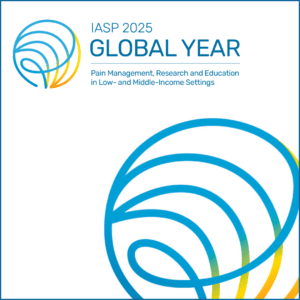In recent years there has been growing interest in how pain and nociception are influenced by visual and proprioceptive inputs. Research has demonstrated that nociceptive inputs, like tactile inputs, are localized using two frames of reference (1). One is somatotopic and it is based on the somatotopic maps in primary somatosensory cortices (S1). That is, stimuli applied to the right hand project to the contralateral S1 and are coded as ‘right’. The second is ‘space-based’ and depends on the relative position of the hand in the space surrounding the body. When the hands are in a canonical position (i.e. the left hand in the left space around the body and the right hand in the right space around the body) there is no conflict between these frames of reference, in the sense that the information is convergent. However, when the hands are crossed over the body midline, there is a conflict regarding the position of the stimulus applied onto the hand: Can I feel the stimulus on the right hand (somatotopic frame) or in the left space (space-based frame), where the left hand is normally found? This conflict may be responsible for the reduction in perception observed when nociceptive stimuli are applied onto the crossed hands (2). This effect, termed ‘crossed-hands analgesia’ has been replicated (3) or partially replicated (4) by other two studies.
In the present study (5) we investigated whether a deficient representation of the space surrounding the body alters crossed-hands analgesia. We recruited a particular group of patients suffering from deficits in the representation of space as a result of a stroke. These patients had developed a syndrome called ‘unilateral neglect’, which is characterized by the inability to attend to stimuli presented in the space contralateral to the lesioned hemisphere, most often the left space. This syndrome cannot be fully explained by primary sensory deficits (6). In our study, we applied mechanical painful stimuli at two intensities to the crossed or uncrossed hands of these patients and asked for a rating of their intensity. The two intensities were used to ensure that participants were able to distinguish the intensity of the stimuli. These ratings were compared to the ratings provided by a group of patients who also experienced a stroke, but did not develop signs of spatial deficits. We also counted how many stimuli were detected by the two groups in the crossed and uncrossed conditions.
Our results showed that the crossed-hands analgesia was not present in most of patients with spatial deficits. In contrast, we observed the opposite prevalence in those patients without any spatial deficit. In specific, only 36% of the patients with spatial deficits showed a reduction in the ratings when the hand was moved from the ‘neglected’ side to the ‘healthy’ side, in comparison to a 69% of patients without spatial deficits. No significant differences were observed for the number of detected stimuli. These results are relevant also for the clinical practice as it has been suggested (7) that early evoked pain (including pinprick pain) can be a predictor, although non-perfect, for the development of central post-stroke pain. In this sense, it becomes clear that if the relative position of the hands in space can influence the perception of the pinprick stimuli depending on the presence or absence of neglect, investigating whether post-stroke patients have preserved space representation is relevant. Future studies should aim to replicate the present findings, and to characterize the exact conditions in which the crossed-hands analgesia is observed in patients with neglect. Indeed, neglect is not an on/off condition, and current neuropsychological pencil and paper test may, occasionally, underestimate its presence.
About Vincenzo Vizzari
 Vincenzo Vizzari is a PhD student in Neuroscience at the University of Turin, Italy. He is interested on the EEG and evoked potentials technique. He is currently writing his PhD thesis, which focuses on the EEG marker of pain.
Vincenzo Vizzari is a PhD student in Neuroscience at the University of Turin, Italy. He is interested on the EEG and evoked potentials technique. He is currently writing his PhD thesis, which focuses on the EEG marker of pain.
About Diana Torta
 Diana Torta is post-doctoral fellow at the Faculty of Psychology and Educational Sciences at KU Leuven (Leuven) and Chargé de Recherche at the Institute of Neuroscience, UCL (Brussels). Her research aims at characterizing the effects of cognition on pain and sensitization, and the mechanisms underlying crossmodal interactions between pain and other sensory modalities.
Diana Torta is post-doctoral fellow at the Faculty of Psychology and Educational Sciences at KU Leuven (Leuven) and Chargé de Recherche at the Institute of Neuroscience, UCL (Brussels). Her research aims at characterizing the effects of cognition on pain and sensitization, and the mechanisms underlying crossmodal interactions between pain and other sensory modalities.
She is funded by an Asthenes long-term structural funding Methusalem grant by the Flemish-Government investing the transition from acute to chronic bodily symptoms (KU Leuven) and by personal grants from the Fund for Scientific Research of the French speaking.
References
[1] Sambo CF, Torta DM, Gallace A, Liang M, Moseley GL, Iannetti GD (2013) The temporal order judgement of tactile and nociceptive stimuli is impaired by crossing the hands over the body midline Pain 154, 242-247.
[2] Gallace, A., Torta, D.M., Moseley, G.L., Iannetti, G.D. (2011). The analgesic effect of crossing the arms. Pain 152, 1418–1423.
[3] Torta, D.M., Diano, M., Costa, T., Gallace, A., Duca, S., Geminiani, G.C., Cauda, F. (2013). Crossing the line of pain: FMRI correlates of crossed-hands analgesia. J Pain 14, 957–965.
[4] Valentini E, Koch K, Aglioti SM. Seeing One’s Own Painful Hand Positioned in the Contralateral Space Reduces Subjective Reports of Pain and Modulates Laser Evoked Potentials. J Pain. 2015 16, 499-507.
[5] Vizzari V, Barba S, Gindri P, Duca S, Giobbe D, Cerrato P, Geminiani G, Torta DM (2017) Mechanical pinprick pain in patients with unilateral spatial neglect: the influence of space representation on the perception of nociceptive stimuli. Eur J Pain 21, 738-749.
[6] Bisiach E, Vallar G (1988) Hemineglect in Humans (North Holland: Elsevier Science Publishers, Biomedical Division).
[7] Klit H, Hansen AP, Marcussen NS, Finnerup NB, Jensen TS (2014) Early evoked pain or dysesthesia is a predictor of central poststroke pain Pain 155, 2699–2706.



